| Posted: Apr 13, 2018 |
Oxide separation anxiety
(Nanowerk News) Controlling the formation of defects in materials is an important part of designing next-generation spintronics, materials for computing that couple magnetic and electrical information. However, it is often difficult to predict how, when, and why defects form.
|
|
Now, researchers at Pacific Northwest National Laboratory led by Dr. Scott Chambers have examined the onset of phase separation defects in oxide thin films, finding that defect formation can be delayed by the surface on which a film is grown. The group showed that electrostatic interactions between the two layers can actually suppress defect formation in the initial stages of crystal growth (Physical Review B, "The onset of phase separation in the double perovskite oxide La2MnNiO6").
|
|
"By understanding these interactions, we can begin to precisely engineer spintronic materials with exciting and useful properties," said lead author Dr. Steven Spurgeon, a materials scientist at PNNL.
|
 |
| The magnetic strength (left) drops when magnetic iron microspheres (black) are wrapped up in a three-dimensional mapping of delayed phase separation in an oxide material, shown as a gap between the substrate (red = SrTiO3) and phase-separated regions (green = NiO). (Image: Pacific Northwest National Laboratory)
|
|
A group at Pacific Northwest National Laboratory examined the growth of a promising oxide material for spintronic computing applications and observed an unusual phase separation mechanism. Instead of splitting into two distinct phases right away, the material grew in a uniform fashion before splintering into a network of nanoscale defects. The group showed that the crystal growth surface influences the gradual buildup of point defects, resulting in a delayed phase separation.
|
|
This result is important because the performance of spintronic devices can be negatively affected by phase separation, which can degrade magnetic properties. The group's findings suggest new ways to control film growth and improve the performance of oxides.
|
|
Materials scientists typically set out to synthesize a specific crystal with desirable properties, but their efforts are often foiled by the presence of unwanted defects that can degrade performance. These defects are sometimes hard to detect, particularly when they occur on the nano- or atomic scale. In this study, PNNL researchers examined La2MnNiO6 oxide thin films, in which they had previously found a network of unwanted secondary NiO crystal phases. They set out to understand the mechanisms driving the formation of these phases to see if the mechanisms could be controlled.
|
|
Using a combination of scanning transmission electron microscopy and atom probe tomography, the researchers examined a large portion of the film and its underlying substrate in 3-D. Strangely, they found that the first several nanometers of the film growth appeared to proceed without defects, and it was not until later that phase separation occurred. At first, they thought this might be the result of a crystal structure changing to match the film to its substrate; however, both X-ray and microscopy measurements showed this wasn't the case.
|
|
The researchers realized that the substrate itself could affect the formation of defects in the growing film, as there is an electrostatic interaction between the two layers. Density functional theory calculations confirmed this hypothesis, showing that charge buildup can drive the formation of small oxygen vacancies, which in turn act as catalysts for phase separation.This study illustrates how the choice of growth parameters, substrate, and point defects interact to form larger scale defects.
|
|
Armed with this information, researchers can now explore the effect of different substrates and growth conditions to achieve better control over the phase separation process for improved spintronic devices.
|

